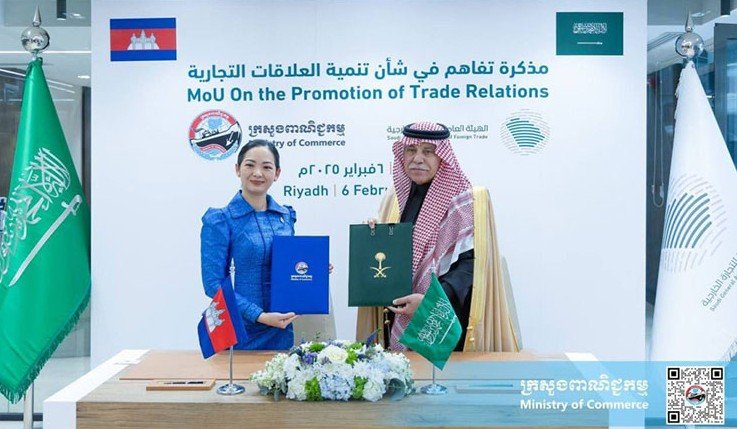As Cambodia is a member of ASEAN, its deepening ties with Saudi Arabia could serve as a gateway for Saudi investment in the broader region
Cambodia and Saudi Arabia have taken significant steps toward strengthening their bilateral relations, marked by economic, diplomatic, and humanitarian cooperation. The recent signing of a Memorandum of Understanding (MoU) on trade relations between the two nations signals a growing partnership that could have profound implications for Southeast Asia and the broader ASEAN region. Saudi Arabia’s increased engagement with Cambodia and ASEAN also aligns with its broader geopolitical and economic strategy, presenting opportunities for regional dynamics.
The Growing Cambodia-Saudi Arabia Partnership
Trade and Economic Cooperation
On February 6, 2024, Cambodia’s Minister of Commerce Cham Nimul and Saudi Arabia’s Minister of Commerce Majid bin Abdullah Al-Kassabi signed an MoU in Riyadh, underscoring a commitment to enhancing trade and exploring new economic opportunities. Cambodia and Saudi Arabia’s trade volume has steadily increased in recent years, rising from $16 million in 2018 to $26 million in 2021. Key Cambodian exports to Saudi Arabia include rice, clothing, footwear, and fruit, while Saudi Arabia exports plastic products, aluminum, fertilizers, and construction materials to Cambodia.
Saudi Arabia’s robust economy and vast consumer market present a promising avenue for Cambodian businesses, particularly in agriculture and textiles. As Saudi Arabia continues its economic diversification under Vision 2030, trade relations with Southeast Asian nations, including Cambodia, will likely expand.
Humanitarian and Development Assistance
Saudi Arabia has extended humanitarian aid to Cambodia through the King Salman Humanitarian Aid and Relief Centre (KSHARC), with over $6 million allocated to various programs. A recent voluntary medical program in Cambodia, facilitated by KSHARC, has fostered people-to-people ties between the two countries. Additionally, Cambodia has welcomed continued humanitarian assistance from Saudi Arabia, reinforcing diplomatic goodwill.
Law Enforcement and Security Cooperation
Beyond economic and humanitarian cooperation, Cambodia and Saudi Arabia are in discussions to enhance security collaboration. A draft MoU on law enforcement cooperation is under review, aimed at facilitating intelligence sharing and law enforcement coordination. This development could bolster Cambodia’s capacity to combat transnational crime while strengthening its diplomatic standing with Saudi Arabia.
Saudi Arabia’s Engagement with ASEAN: A Strategic Shift
Saudi Arabia’s ASEAN Partnership
Saudi Arabia’s accession to the Treaty of Amity and Cooperation in Southeast Asia (TAC) and its status as an ASEAN Sectoral Dialogue Partner reflect its commitment to regional diplomacy. By engaging with ASEAN, Saudi Arabia is expanding its influence beyond the Middle East and Africa, positioning itself as a key player in Southeast Asian economic and security affairs.
As Cambodia is a member of ASEAN, its deepening ties with Saudi Arabia could serve as a gateway for Saudi investment in the broader region. This aligns with Saudi Arabia’s broader strategy of fostering trade and diplomatic relations in dynamic markets, particularly in Southeast Asia’s rapidly growing economies.
Implications for ASEAN Nations
Saudi Arabia’s growing presence in ASEAN could yield several impacts:
Economic Growth and Investment: Increased Saudi investment in Cambodia may extend to other ASEAN nations, particularly in infrastructure, energy, and agriculture.
Energy Cooperation: Given Saudi Arabia’s role as a leading oil exporter, stronger ties with ASEAN could enhance regional energy security.
Security and Counterterrorism: Saudi engagement in regional security dialogues may contribute to counterterrorism efforts, especially given ASEAN’s concerns over extremist threats.
Labor and Migration: Saudi Arabia is a key destination for Southeast Asian migrant workers, and its closer ties with Cambodia could lead to improved labor policies and protections for migrant workers.
Conclusion
The strengthening of Cambodia-Saudi Arabia relations marks a significant shift in Southeast Asian geopolitics. With growing economic, humanitarian, and security cooperation, both countries stand to benefit from expanded bilateral engagement. Saudi Arabia’s deeper integration into ASEAN presents broader regional implications, offering new opportunities for trade, energy security, and diplomatic collaboration. However, Cambodia and ASEAN must strategically manage these engagements to balance regional partnerships and navigate the evolving geopolitical landscape. The growing relationship between Cambodia and Saudi Arabia will likely continue to shape Southeast Asia’s economic and diplomatic future.


